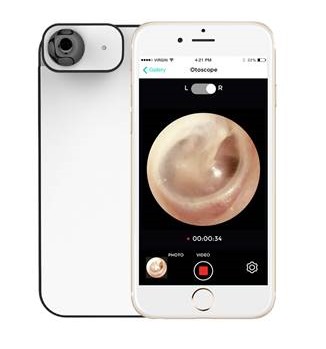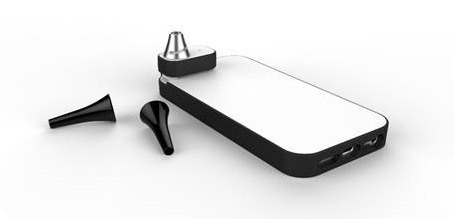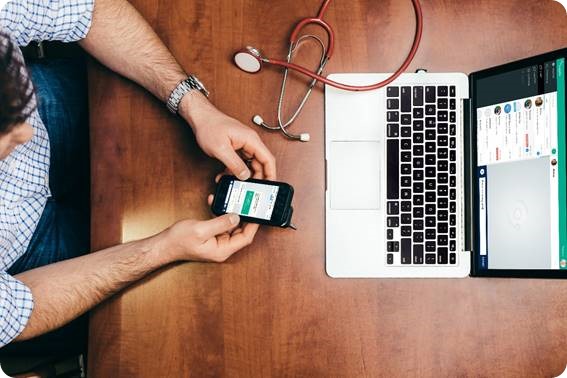An interview with Helene Viatge conducted by April Cashin-Garbutt, MA (Cantab)
How do traditional otoscopes work and what was the vision behind TYM?
The traditional device manufacturers used by doctors such as Welch Allyn, Keeler and Heine aren’t digital. It means that they have an external light source (with a battery) and are used to look into the ears but the doctors can’t capture the images.
Thus, traditional otoscopes do not have the benefit of allowing users to store images, to track conditions over time, to explain to medical students and to share images remotely for second opinions.
In addition, the size of the image that can be seen through standard existing otoscopes is nowhere near as large and clear as the one captured by TYM.

Finally, TYM is sold for £99 compared to prices of between £150 and £250 for standard professional otoscopes. The traditional brands have manufactured digital otoscopes, but these devices are quite big and very expensive (often starting at £600).
TYM was creating with the belief that most primary care devices such as the otoscope haven’t evolved since created and that smartphone technology could greatly improve healthcare delivery and make doctors’ life easier and more efficient. 
What stage of development is TYM at and is TYM classified as a medical device?
TYM is classified as a class 1 medical device and is ready for launch.
Can you share images and videos collected using the TYM to other HCPs for remote opinions?
Yes. TYM comes along with the Cupris Health Platform (app and web platform).
It enables users to:
- Capture clinical images of patient conditions using their smartphones.
- Add information using questionnaires, audio recordings, text input, and other tools built into the smartphone app.
- Securely connect with other Cupris users to share cases with them through the cloud service.
- Discuss and monitor patient cases, and receive diagnoses of patient conditions without seeing patients in person.
The software platform is cross-specialty so can be used for the remote consultation of a wide variety of health complaints.
If the other HCPs aren’t using Cupris Health Platform, they will be sent an invitation to join. You can in between share with them a pdf of the full patient case (easily exported through the app).

How do you make sure that the images and videos are shared securely?
Cupris is NHS IG Toolkit compliant. In addition, all data stored and shared through Cupris Health Platform is encrypted twice, following the AES256 standard (Standard accepted form of encryption that HSCIC specifies on their site -http://systems.hscic.gov.uk/infogov/security/infrasec/gpg/acs.pdf).
Finally, our server provider, UK Fast, is an approved N3 connector. Our infrastructure has been reviewed and approved by an approved N3 aggregator, Skyscape.
Can TYM images integrate with Electronic Medical Records (EMR)?
Yes. TYM images and videos, as well as patient information collected through Cupris Health Platform, can be integrated easily with EMIS Web, the biggest EMR provider in the UK.
Cupris is also in discussions with the other EMR providers to integrate with them. Doctors can always export images as a pdf and attached them to the patient EMR.

Is the platform IG compliant?
Yes, it is NHS IG Compliant.
What feedback have you received about TYM so far?
We have received excellent feedback so far about TYM. Doctors love being able to show their patients what is wrong with them and better explain the condition and treatment. Most of them says they have rarely seen such a clear image and it will make their life easier to use such a device. The ability to store and share is obviously of a great advantage and they consider it as a significant improvement for education and training as well.
What were the main challenges you had to overcome when developing TYM and what further advances are in the pipeline for TYM?
We had several challenges. One of them was to manufacture a product that is compatible with standard speculum for doctors to be able to use it with the common on-the-shelf speculums. Another one was to bring as much light as possible from the phone’s flash to the end of the speculum. In the pipeline a fit-all-phones version of TYM will be developed.
Do Cupris plan to develop any other smartphone-connected devices?
 Yes. Cupris’s second device is an Ophthalmoscope for retinal imaging. This will widen the market to an additional specialty, ophthalmology, and to monitoring diseases such as diabetes.
Yes. Cupris’s second device is an Ophthalmoscope for retinal imaging. This will widen the market to an additional specialty, ophthalmology, and to monitoring diseases such as diabetes.
Cupris will also develop a dermatoscope since tele-dermatology has already been tested in several CCGs. Finally, a stethoscope adapter will be developed so that Cupris can offer a full GP Toolkit with the four main tools used in primary care.
About Helene Viatge
 Helene has worked in the health sector for over 7 years for large medical device companies such as GE Healthcare and Sorin Group and for the largest French corporate health insurance provider, Humanis.
Helene has worked in the health sector for over 7 years for large medical device companies such as GE Healthcare and Sorin Group and for the largest French corporate health insurance provider, Humanis.
She has worked in a variety of roles covering sales and marketing, research and development and strategy consultancy to Humanis' CEO.